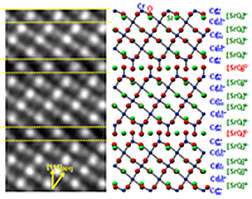- Number 421 |
- September 1, 2014
Chromium's bonding angles let oxygen move quickly

Ordered, nanostructured, rhombohedral
phase, SrCrO2.8 showing oxygen-deficient
SrO2 planes.
By taking advantage of the natural tendency of chromium atoms to avoid certain bonding environments, scientists at DOE’s Pacific Northwest National Laboratory have generated a material that allows oxygen to move through it very efficiently, and at relatively low temperatures. Specifically, they found that their attempts to make metallic SrCrO3 lead instead to the formation of semiconducting SrCrO2.8. Because chromium as an ion with a charge of +4 does not like to form 90º bonds with oxygen, as it must in SrCrO3, SrCrO2.8 forms instead with a completely different crystal structure. This material contains oxygen-deficient planes through which oxygen can diffuse very easily.
"If oxygen vacancies are present at high enough concentrations, they can aggregate and form new ordered structures," said materials expert Dr. Scott Chambers, the PNNL Laboratory Fellow who led the research. "These ordered structures can have properties not observed in the host-creating novel, mesoscale crystals."
As a nation, we are always looking to create new and improved devices. Yet, the limits of what can be achieved with conventional materials, such as silicon-based electronics, are clearly on the horizon. This work represents an important scientific advancement relevant to increasing the efficiency of solid oxide fuel cells, which require oxides capable of absorbing and transmitting oxygen anions at low temperature.
"As an additional benefit, ordered arrays of oxygen vacancies might allow for the spatial separation of electronic and vibrational degrees of freedom," said Chambers. "This property would be useful in, for example, increasing the performance of thermoelectrics."
In the near term, the team plans to apply the understanding gained to the deposition, characterization, and understanding of epitaxial strontium-doped lanthanum chromite. This material is of potential importance in visible light harvesting. In the long term, the team plans to exploit the observed phenomenon to carry out nanofabrication of novel heterogeneous catalytic structures.
This work was supported by DOE’s Office of Science, Office of Basic Energy Sciences, Division of Materials Sciences and Engineering (HZ, YD, PS, MB, RC, SC) and the William R. Wiley EMSL postdoctoral fellowship (RC). The computational work done by Peter Sushko was also supported in part by the PNNL Laboratory Directed Research and Development program. Research was performed in EMSL, a DOE scientific user facility.[Kristin Manke, 509.372.6011,
kristin.manke@pnnl.gov]
